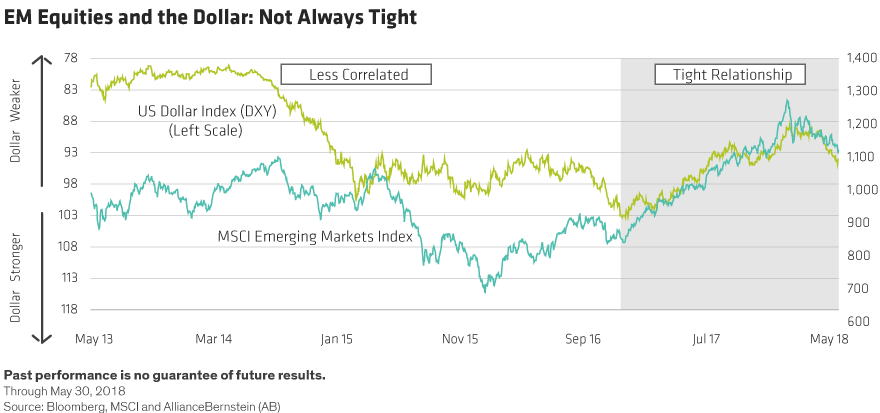Fundamental market relationships maintain their shape despite a bias toward trend extrapolation.
by Erik Knutzen, Chief Investment Officer – Multi-Asset Class, Neuberger Berman
There are some strong trends in markets at the moment, and some notable thresholds being crossed. Recent U.S. dollar strength is one example; oil is another, with WTI crude consolidating above $70/bbl and Brent hitting $80/bbl. Even after a pullback last week, the 10-year U.S. Treasury yield is holding its ground at around 3%.
Human beings like to extrapolate current trends into the future. They also tend to be distracted by headline noise and eye-catching round numbers. Those are risky habits, however, because they ignore fundamental economic relationships. Like elastic bands, these relationships tend to put a limit on trends and hold the market in shape; they also provide asset allocators with useful intellectual anchors amid the noise and uncertainty.
Human Beings Like to Extrapolate
When oil went from $100/bbl to $30/bbl through 2015, out came the analyst notes predicting “$10 oil.” Today, we are seeing a sharp rise in Brent crude $100 call options, according to data from Intercontinental Exchange.
Similarly, the last time the U.S. 10-year yield broke through 3% was in the aftermath of the “taper tantrum,” which passed its five-year anniversary last week. The Fed’s announcement of its quantitative easing exit plan triggered a surge in yields, which breached 3% just in time for everyone’s 2014 previews. Many predicted that 4% was on the way. We were back at 1.3% a year-and-a-half later.
Over time, momentum investing attracts a risk premium. Our own Multi-Asset and Multi-Style Risk Premia strategies seek to benefit from it. Trends tend to die out gradually, but investors get paid a risk premium because sometimes they snap back without warning. Either way, historically elastic-but-fundamental economic relationships have eventually asserted themselves.
Yield Differentials, Dollar Strength
Back in 2014, the elastic band in question was the one tying the back end of the yield curve with the front. When short-dated interest rates are anchored, long-dated yields can go only so high. A 4% yield might sound reasonable for the 10-year Treasury; but remember, if the rate offered for the first five years is very low, the rate for the second five years will need to be much higher to make up for it. The improbability of that was an important reason why the 10-year yield refused to power through 3% back in 2014 despite all the predictions.
Today, an important set of stretched elastic bands are the ones joining U.S. Treasury yields with other G10 bond yields and the U.S. dollar. As some analysts have pointed out, U.S. yields are the highest among the G10, and the U.S. five-year yield is higher even than all the other G10 10-year yields. Those rate differentials should attract international investors to U.S. assets and support a stronger dollar, but they also discourage investment in U.S. assets by making it very costly for investors to hedge dollar exposures back to their home currencies.
The three current trends of higher U.S. yields, widening rate differentials and a strengthening dollar are all real, but it is difficult to see how all three can go on forever because fundamentally they pull in different directions.
Fundamental Relationships Maintain Their Shape
Fundamental economic and market relationships like these will maintain their shape regardless of our bias toward trend extrapolation and our potential to be distracted by day-to-day noise. That makes them useful intellectual anchors for investors and asset allocators.
They remind us to keep first principles in mind as we consider our risk exposures. Are we well diversified between economic growth, inflation and interest rate risks? What views are we expressing in our portfolios and are they internally consistent? And when valuations appear full or stretched across many asset classes, are there components of our portfolios that stand to benefit should the elastic bands snap back?
Copyright © Neuberger Berman
















